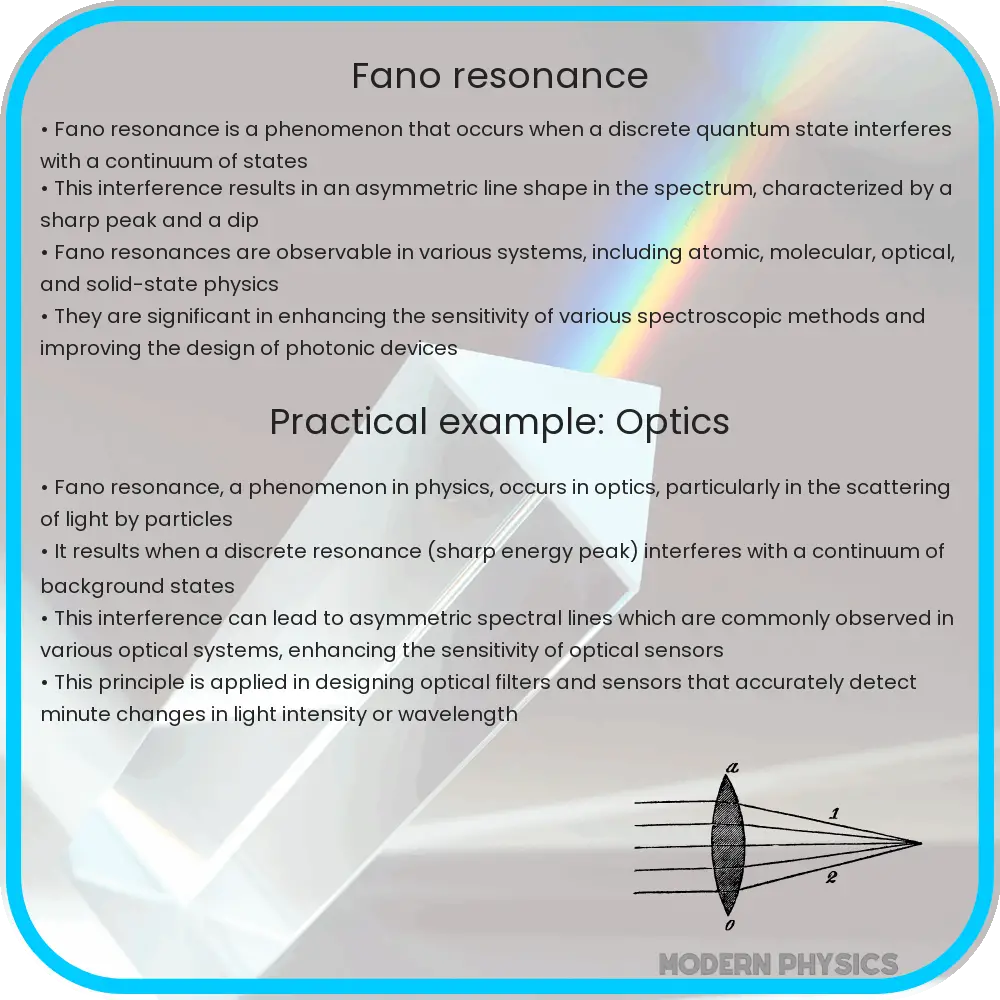Explore Fano Resonance in electrodynamics: its theory, applications in photonics, quantum computing, and future technological impacts.

Fano Resonance: An Insight into Electrodynamics
The phenomenon of Fano Resonance represents a fascinating aspect of electrodynamics, showcasing the intricate interplay between quantum states and electromagnetic waves. This concept, initially discovered by Italian physicist Ugo Fano in the 1960s, has since become a cornerstone in the field of optical and electronic research due to its unique characteristics and wide range of applications.
Theoretical Background
At its core, Fano Resonance arises from the interference between a discrete quantum state and a continuum of states. This interaction leads to an asymmetric line shape in the absorption or transmission spectrum, characterized by a sharp peak followed by a steep decline. Mathematically, the Fano resonance profile is described by the formula:
\[ \frac{(q + \epsilon)^2}{1 + \epsilon^2} \]
where ‘ε’ represents the energy detuning normalized to the width of the resonance, and ‘q’ is the Fano parameter, indicating the strength and nature of the interference.
Electrodynamics Applications
Fano Resonance has significant implications in various fields of physics and engineering. In photonics, it’s used to enhance light-matter interactions in nanostructures, leading to advancements in sensor technology and optical filters. In the realm of quantum computing, understanding Fano Resonance is essential for developing qubits and manipulating quantum states. Moreover, in plasmonics, it allows for the control of light on a nanoscale, opening doors to highly efficient solar cells and improved biosensors.
Recent Developments
Recent advancements have expanded the applications of Fano Resonance beyond traditional fields. For instance, in metamaterials, researchers utilize this resonance to create materials with negative refractive indices, leading to the development of superlenses and cloaking devices. Additionally, in terahertz technology, Fano Resonance enhances the detection and manipulation of terahertz radiation, which is pivotal in security scanning and medical imaging.
The ongoing research and exploration into Fano Resonance continue to unveil its potential, promising revolutionary impacts across various scientific and technological domains.
Advanced Theoretical Insights
Delving deeper into the theory, Fano Resonance is not limited to electromagnetic interactions but extends to acoustic and mechanical systems as well. This universality stems from its foundational principle – the interference between discrete and continuum states. Researchers are exploring these principles in acoustic metamaterials, leading to the development of noise-cancellation systems and new sound control technologies.
Challenges and Future Directions
Despite its vast potential, Fano Resonance presents unique challenges. One of the primary issues is the precise control of resonance characteristics, which is crucial for application in quantum computing and nanophotonics. Additionally, integrating these phenomena into practical devices requires overcoming material and fabrication limitations. Future research is directed towards refining the control mechanisms of Fano Resonance and exploring new materials that can more effectively harness its properties.
Interdisciplinary Impact
The interdisciplinary nature of Fano Resonance underscores its significance. Its principles are applicable in fields ranging from material science to biological sensing, making it a focal point of interdisciplinary research. Innovations inspired by Fano Resonance principles are contributing to breakthroughs in drug delivery systems, environmental monitoring, and even artistic endeavors in visual and acoustic arts.
Conclusion
In conclusion, Fano Resonance is a pivotal concept in electrodynamics, offering profound insights and applications across a multitude of scientific disciplines. From enhancing the efficiency of solar cells to pushing the boundaries of quantum computing, its impact is both far-reaching and multifaceted. As research continues, the potential applications of Fano Resonance are bound to expand, presenting exciting possibilities for future technological and scientific advancements. The ongoing exploration of this phenomenon not only deepens our understanding of the quantum world but also paves the way for innovative solutions to some of the most complex challenges in science and technology today.
